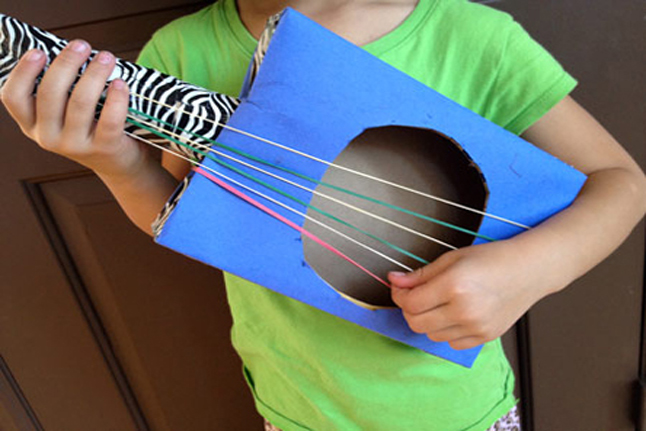Simple Musical Instruments
Photo from PBS Parents’ Crafts for Kids.
Activity from Teachengineering.org, contributed by the Integrated Teaching and Learning Program, College of Engineering, University of Colorado at Boulder. See The Energy of Music and Making Music for the complete lesson plan and other activities about sound and music engineering.
Grade level: 3-5
Time: 30 minutes
Summary
Students in grades 3 – 5 work with partners to investigate sound frequencies and acoustic engineering by creating four different instruments – a shoebox guitar, water-glass xylophone, straw panpipe, and soda bottle organ. Teams can choose to make one instrument or all four!
Engineering connection
Acoustic engineers help design effective auditoriums (and other spaces) so that everyone in the audience can hear the music that is being produced on stage. To do that, they must understand music and the frequencies at which different notes are formed.
Learning objectives
- Explain that high frequencies produce high-pitched sounds, and low frequencies produce low-pitched sounds.
- Understand the connection between sound waves and frequency.
Standards
International Technology and Engineering Educators Association
- D. Tools, materials, and skills are used to make things and carry out tasks.
- C. Various relationships exist between technology and other fields of study.
Next Generation Science Standards
- Develop a model of waves to describe patterns in terms of amplitude and wavelength and that waves can cause objects to move. (Grade 4)
Introduction/Motivation
Materials
Water-Glass Xylophone:
- 4 or 5 same-sized glass glasses
- water
- metal spoon, any size
- Instrument Construction Worksheet, one per student
Straw Panpipe:
- 4-8 straws
- tape (masking or cellophane)
- scissors
- Instrument Construction Worksheet, one per student
Bottle Organ:
- 5 same-sized plastic soda bottles
- water
- Instrument Construction Worksheet, one per student
Shoe Box Guitar:
- sturdy shoebox
- 8-10 rubber bands of varying widths
- pencil
- Instrument Construction Worksheet, one per student
Procedure
Background
Before the Activity
- Gather materials.
- Make copies of the Instrument Construction Worksheet, one per student.
- Make a sample musical instrument of each type to show the class before the activity begins
With the Students
- Divide the class into teams of two students each.
- Have teams spend a few minutes deciding which instrument they wish to construct.
- Hand out the worksheets. Provide groups with the materials for their chosen instruments.
- Direct students to begin designing and creating their instruments. Help with construction when necessary. Instrument instructions are listed below.
- Once students have completed their instruments, give them time to practice playing them.
- Ask students questions regarding the frequency of the created sounds. For example: Do you think that your panpipe is making high or low frequency sounds? (Reminder: Higher frequency sounds are higher pitch sounds, while slower frequency sounds are the lower sounds.)
Instrument Instructions
Safety Issues
Troubleshooting Tips
Investigating Questions
- How many different kinds of instruments are in an orchestra?
- How long does it take to build a piano? A guitar? A harp?
- What does an acoustical engineer do?
- What did you notice about the different sounds the instruments make?
- Do higher pitched sounds have frequency, or greater wavelength, or both? (Answer: Higher frequency = higher pitch = smaller wavelength)
- Are some instruments louder than others? Why? (Answer: Greater air pressure is created by the louder instruments, resulting in higher amplitude, or loudness.)
- Can you control the loudness of your instruments? How? (Answer: By blowing harder into an instrument or plucking strings with more force, you are exerting more energy and thereby creating more pressure.)
Post-Activity Assessment
Activity Extensions
Activity Scaling
- For upper grades, spend more time creating instruments, tune them using tuners, and play a song together.
Additional resources
Crafts for Kids: Shoebox Guitar. PBS Parents website has this project from Jen Goode’s Projects for Preschoolers.
Make a Toy Guitar. Projects for Preschoolers has step by step directions for turning a recycled cracker box into an musical instrument.
Contributors: Jessica Todd, Brad Dunkin, Luke Simmons, Brian Kay, Frank Burkholder, Abigail Watrous, Janet Yowell Copyright © 2007 by the Regents of the University of Colorado.
Filed under: Class Activities, Grades K-5, Grades K-5, Lesson Plans
Tags: acoustic engineering, build, Class Activities, Design, frequency, Grades K-5, guitar, hands-on activities, instrument, Music engineering, noise, sound, waves, xylophone










